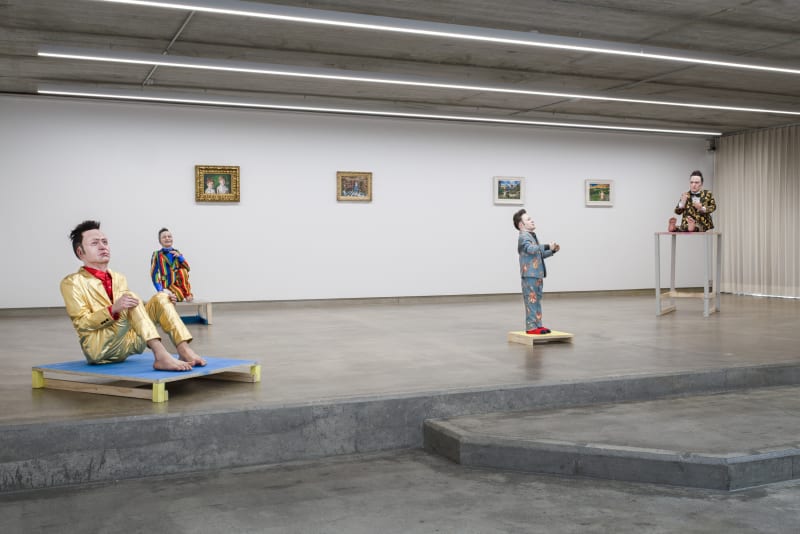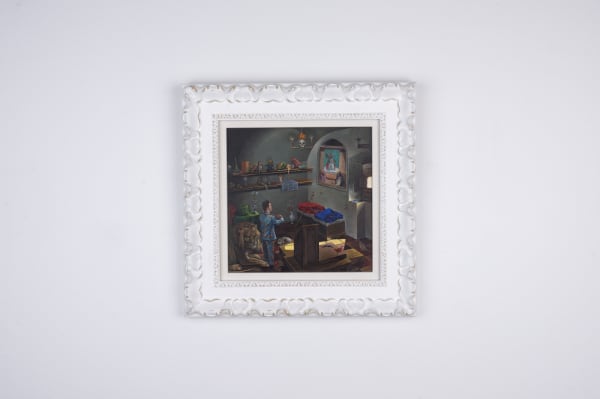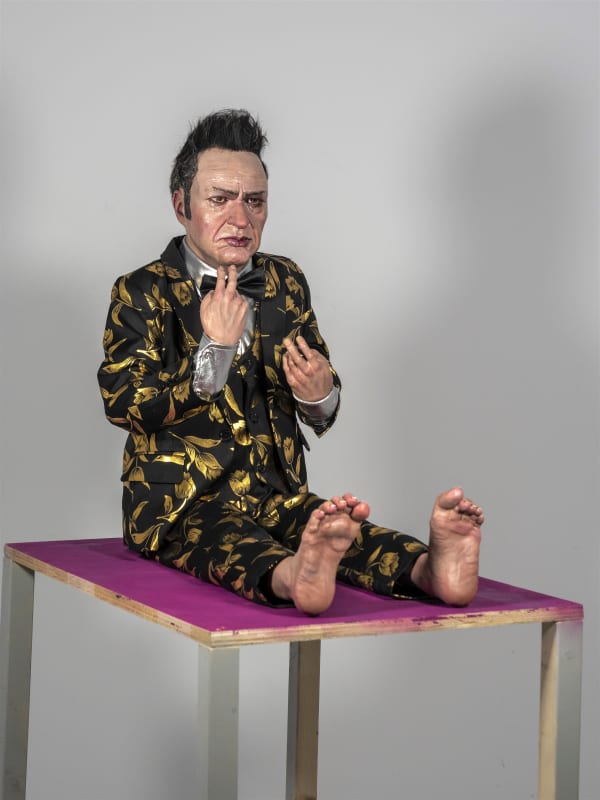enrique marty: mutatis mutandis
Past exhibition
Overview
KETELEER GALLERY is very pleased to present Mutatis Mutandis – Changing what needs to be changed, a new solo exhibition by Enrique Marty (°1969. Salamanca, Spain), his second solo exhibition in the new Platform 6a space and a return to where his collaboration with Deweer Gallery began. The exhibition consists of an entirely new series of exceptional sculptures and watercolours.
Press release
Enrique Marty’s new oeuvre is the result of 18 months of work and a continuation on themes with which he has been working for a long time such as the ‘unheimliche’ of the family sphere, social and individual behavioural structures, the absurdity of life and society, memories, art history … but also the typical visual and narrative systems the art world seems to use over and over again.
Marty wants to resist the temptation of using a superficially recognizable visual language to connect the works from different series to make things easier to understand. From the aesthetic point of view the series differ greatly. Marty allows himself total freedom and lets the subject inform his aesthetic decisions. Marty has been using this strategy of prioritizing subject matter over visual qualities since the beginning of his career and this has allowed him to follow the depths of his thinking in a rewardingly unrestrained manner. At the conceptual level, however, there’s a strong thematic connection to be found between the series. The new works are all, in their own unique way, reflections on the inevitability of transience and change, inspired by recent events such as the pandemic, at a global level, and the death of his parents, on a personal level.
In the Orphan (The states of mourning) series (2020) the artist has depicted himself, 8 times, child-sized, going through the 5 stages of grief: denial, anger, negotiation, depression and acceptance. It’s unclear which sculpture represents which stage, the titles aren’t of much help either, and so we’re lured into examining up close; interpreting each statue’s facial expression and body language by digging into our own memories and emotions, projecting them onto the works to understand what we’re seeing. The grieving sculptures are dressed in colourful, festive attire – opposed to the black uniform we’re accustomed to – another element to aid our confusion. The hyper-realness of existential dread expressed in the confronting vulnerability of the self-portraits is juxtaposed with a great deal of humour bordering on self-deprecating irony. Marty’s works are never, and never have been, one-dimensional… The 5 stages are well-known for being an inevitable part of moving on. When reality changes to a significant degree, we need to change along. A rebirth of some degree is the only way to join an altered future, the only way to survive in it. The self-portraits of the artist culminate in a sculpture which personifies him as a Wicker Man (2020): a symbol and fetish of Pagan beliefs that represents a feast of sacrifice and death leading to rebirth and abundance.
All Your World is Pointless (2020/2013) episode VII; part 1 (2020/2019) is part one of three of episode VII of the movie All Your World is Pointless. It is a frame-by-frame animation film made with dolls and sets which, unlike the previous episodes, is made with pictorial animation. Marty uses one of his self-portraits to play the role of the mysterious historical figure Kaspar Hauser, the man who had no identity, no past or – since he was killed at a very young age – future. Hauser was dropped on the streets of Nuremburg, supposedly by his parents after years of neglect, unable to walk or talk properly. The case offers a unique though heart-breaking insight into the effects of environment, education and society on the development of human beings as we know them and what happens if none of this is provided to someone, how without the right nurture, man’s nature can be dramatically altered. Keeping epigenetics and our rapidly changing social and environmental conditions in consideration, his life becomes a poignant warning for the future.
The Animalmineralvegetal Man (2020) series consists of ten small sculptures strategically posing as decorative porcelain figurines. On closer look, however, these figurines are nothing like the well-known innocent collectibles. They’ve devoured all familiar references and turned into supranormal mutants: they’re animal, man, mineral and plant all-in-one; a reflection on our contemporary point of view on physical mutation. The title of the series refers to the shape-shifting superhero mutants known from comic books: modern-day substitutes for classical mythological heroes: creatures with powers exceeding ours. In Marty’s mutants however, all biological kingdoms have converged into restless creatures looking for a physical state “superior” to that of mere superhumans: über-organisms if you will. Or are these the results of an excessively dominated and therefore confused nature? They go above and beyond what we know from classical myths. Perhaps the imagination of the past doesn’t suffice anymore in times where surpassing the natural limits of human nature through genetic modifications is becoming increasingly realistic, turning the fantastical into the ordinary.
Non-melancholic scenes (2020) is a series articulated around small-format paintings referencing, in terms of technique and codes of representation, 15th and 16th century paintings. The technique, format, themes and symbolism were intended to create a sense of enigma, soliciting our careful observation. Although we’re faced with situations whose codes imply narratives, we’re left disoriented by the lack of anything coherent or substantial to cling to. Even the title, denying melancholy by affirming its expectation, is enigmatic in itself. The works, in fact, represent scenes from antiquity, with interspersed modern elements, occurring at twilight. A few works have a clear relationship with the Orphan series as some of its characters re-appear in them. Genres such as mythology, landscapes, religion, portraits, heroism and cabinet paintings are also strategically employed as conceptual tools, creating fascination and confusion in a minefield of unhinged symbols.
The Designs for tapestries series started in 2009 and uses the same narrative strategies as mentioned above but was inspired by the small-format paintings that served as models for the realization of huge tapestries. Just like the Non-melancholic scenes, and in fact all the series shown in this exhibition, well-known references function as a camouflage for hidden narratives waiting to be deciphered, offering the viewer a seemingly straightforward point of reference which ultimately leads him into bewilderment.
Text by Enrique Marty & Lauren Wiggers.
Installation Views
Works
-
 Enrique Marty, Non-melancholic scenes.1, 2020
Enrique Marty, Non-melancholic scenes.1, 2020 -
 Enrique Marty, Non-melancholic scenes.4, 2020
Enrique Marty, Non-melancholic scenes.4, 2020 -
 Enrique Marty, Non-melancholic scenes.9, 2020
Enrique Marty, Non-melancholic scenes.9, 2020 -
 Enrique Marty, Non-melancholic scenes.6, 2020
Enrique Marty, Non-melancholic scenes.6, 2020
-
 Enrique Marty, Non-melancholic scenes.1, 2020
Enrique Marty, Non-melancholic scenes.1, 2020 -
 Enrique Marty, Non-melancholic scenes.7, 2020
Enrique Marty, Non-melancholic scenes.7, 2020 -
 Enrique Marty, Non-melancholic scenes.3, 2020
Enrique Marty, Non-melancholic scenes.3, 2020 -
 Enrique Marty, Non-melancholic scenes.10, 2020
Enrique Marty, Non-melancholic scenes.10, 2020

























